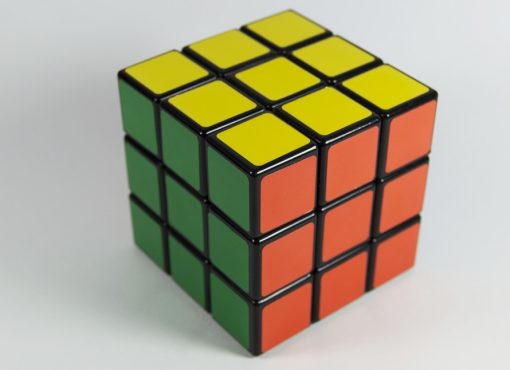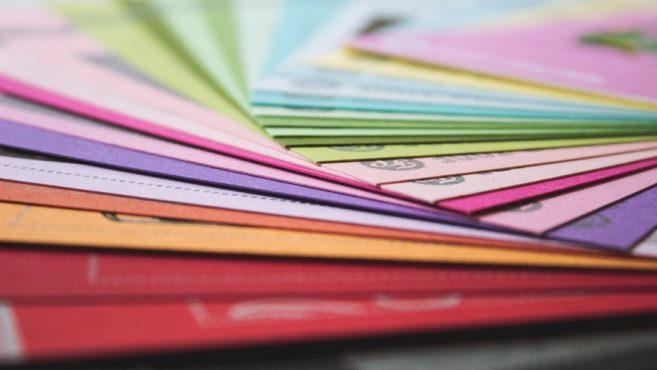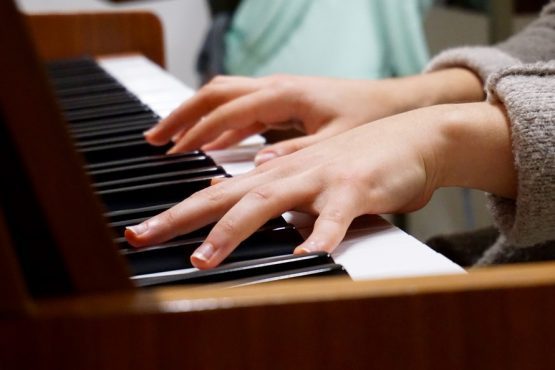
Well-meaning piano teachers sit students down at the piano, and immediately take out the method book, and show their student, for example, where middle C is on the staff, and where it is on the piano…They begin with the eye, and with reading, with little, if any, attention to a student’s audiation. If we instead begin with a student’s audiation, then when they do read, they will be reading pitches and durations that are already in their mind. – Andy Mullen
In this article, Andy Mullen from the Improving Musician blog delves deeper into the Music Learning Theory concept of audiation and how it improves students’ understanding of music before they even play.
The above quote is taken directly from this article and it got me thinking about the order in which we teach our students.
What if students already understood the notes they were learning to play, if they could hear them in their heads, sing them out load, understand them in a tonal context, improvise on them, etc.? How much more effective would learning to read be?
I think this is the missing piece in teaching musical understanding and Andy has created some of the best videos to explain these concepts.
I know you’re going to love this article. Don’t skip over the videos! – Tim Topham.
ps. Andy will be on the Podcast this Friday (Episode 52) putting all of this into action live. It was one of the most enjoyable and pedagogically interesting podcasts I’ve recorded and I’m still thinking about its impact on my own teaching. Don’t miss it.
In my 6th grade keyboard lab, our cumulating piece is “Ode To Joy.” The students’ performance task is to play the melody in the right hand, and a simple bass line in the left. I assess them individually.
Several times each year, instead of playing the piece in C Major, a student plays the piece with their thumb on the wrong note. They play through the whole song either in D Dorian, F Lydian, B Locrian, or perhaps even some dreadful combination, and they have NO IDEA that what they are playing sounds wrong.
If I simply shift their hands, and put them in the right place, that puts a band-aid on the problem, and gets them through the performance task.
However, the problem still exists: our students at large are not independent musical thinkers. They are imitators.
As music teachers, we are often forced to teach beginner (and not-so-beginner!) students everything by rote: notes, rhythms, harmonies, and the like.

When I first began teaching, while I loved seeing what students could do, I was frustrated by what they couldn’t do. The vast majority couldn’t read or write, they couldn’t improvise, and above all, they relied on me to show them everything.
In short, there was very little generalization to be made from piece to piece. They were simply imitating with no understanding of the big picture.
After I had been teaching for a number of years, I discovered Music Learning Theory and the concept of teaching students to audiate, that is, to think musically.

I was always a great audiater, and was a far better “faker” than a reader. I always thought that was a hindrance. But, what I discovered from Music Learning Theory (MLT), is that we need to be able to audiate before we read. Once students can audiate, they will become independent musical thinkers who are able to read, write, and improvise with comprehension.
But what’s it all about?
Audiation is defined as the ability to hear music – and understand that music – for which the sound may or may not be physically present. Dr. Edwin Gordon, the creator of MLT, argues that in the same way that thought is the basis of language, audiation (musical thought) is the basis of musical understanding, and therefore based his Music Learning Theory on the necessary steps toward audiation.
When students learn the lines and spaces in notation before they can audiate tonality, they aren’t really reading. They are simply decoding, and pressing keys that have no meaning for them.
In order to audiate, we must be aware of the three main musical elements: melody, harmony, and rhythm.
Music, like language, has both Content and Context. In language, we can learn words, but it’s not until we hear them used in a sentence, or attach an object to a word, that we truly understand them.
In music, content could be the notes and rhythms you are playing. Context is the tonality or meter in which you play. If, for example, you play an E and a G together on the piano. (Content) Each new tonality (Context) we place that interval in will have a completely new sound. C Major, E Minor, C# Locrian, A Dorian…it’s not until we hear a Context that the Content will truly make sense.

By teaching students the Context (tonality, meter, harmonic and rhythmic function) of the Content (songs and etudes), students are well on their way to be able to make generalizations about music, and perhaps above all, make predictions about what will be coming next.
Students in an MLT setting aurally learn many tonalities and many meters so they can make as many comparisons as possible. In the beginning, they need to have two tonalities (Major and Minor) and two meters (Duple and Triple) so that they can make aural comparisons. Gordon often said, “We learn what something is by learning what it is not.”
To assist my students in beginning to hear and make aural comparisons amongst various tonalities and meters, I have created a YouTube playlist of Etunes (a play on the word etude and tunes). I wrote and recorded these very brief tunes so that students will have a “go-to” tune in each of the tonalities.
When students learn a musical instrument, they are actually learning two instruments: the audiation instrument (their musical brain), and the physical instrument itself. Gordon is fond of statements like, “An instrument has no sense of pitch or rhythm.” As instrumentalists, we need to bring pitch and rhythm TO an instrument.

When it comes to playing an instrument, if we are audiating we should be able to say, for example, what tonality we are playing in (Major, Minor, Dorian, Mixolydian), what the underlying harmonic functions are (I, IV, V), what meter we are in (Duple, Triple), and what are the functional pitches (scale degrees) of the melody.
Too often, teachers teach songs to their students with little to no explanation of musical context. MLT tries to break its teachers of that precarious cycle so their students eventually are independent musical thinkers!
As teachers, we need to set goals for our students, and musicianship is no exception. Well-meaning piano teachers sit students down at the piano, and immediately take out the method book, and show their student, for example, where middle C is on the staff, and where it is on the piano (as if “C” has any meaning to a student’s audiation!). They begin with the eye, and with reading, with little, if any, attention to a student’s audiation.
If we instead begin with a student’s audiation, then when they do read, they will be reading pitches and durations that are already in their mind. As Gordon says,
“They will be bringing meaning to notation, rather than trying to extract meaning from notation.”
To that end, we need to establish audiation goals for our students. What do we want them to be able to do musically before we introduce notation?
In my own personal teaching, I have defined a Basic Musicianship that is a prerequisite to reading. I want my students to have a basic working knowledge of Rhythm, Melody, and Harmony.

Music Learning Theory gives us the tools and the frameworks for establishing these initial objectives. Once students can meet the initial audiation objective they are ready to deal with music notation, and to bring meaning to what they are performing on their instrument.
RHYTHM (Duple and Triple)
TONAL (Major and Minor)
To assist my students and fellow teachers, I have created a series of videos called “Audiation Station.”
These free videos take students through a basic series of Tonal and Rhythm Patterns so that they can learn to audiate. Teachers can use these as a model, and provide access to these videos for students at home. This will jumpstart their (and your!) audiation.
So, then, how is audiation taught?
MLT teachers teach Tonal and Rhythm skills to their students as a prerequisite (ideally) or concurrently with instrumental instruction. These skills are called Learning Sequence Activities, and break up musical understanding into manageable chunks of information: Tonal Patterns and Rhythm Patterns.
Each level of learning is a readiness for the next level of learning, and that continues, on and on, until music understanding is met. (That can last a lifetime!) The skills taught will provide context to the content being taught at the keyboard.
Learning music is often compared to learning another language. Even though music is not a language in the strictest sense, one can certainly communicate with music. Tonal patterns and Rhythm patterns are the words of music.
In language, we rarely deal with one letter at a time, we read words. MLT teaches students a vocabulary of patterns, and organizes those patterns based on how they function in the music.
Teaching our students to audiate tonally and rhythmically should be part of every lesson. Once students master tonal and rhythm patterns, we are able to teach them literature with greater understanding. They will be able to make generalizations from piece to piece, and read with fluency and understanding.
Since I began teaching students in an audiation setting, the number of times each year where students haphazardly play in the wrong tonality has decreased dramatically. Once a student begins to learn to audiate, many wonderful things begin to happen to their piano playing:

After students have developed their audiation instrument, they are ready to make sense of what is is they are doing when they are playing the instrument. MLT asks us to move beyond simple imitation, and teaches us and our students to understand music. By breaking music down into its fundamental parts (melody, harmony, and rhythm), we can begin to communicate with music.
Once you’ve had a chance to absorb the above text and watched the videos, please let me know if you have any questions about MLT or Audiation – I’d be happy to help.
Please leave your question below.

Dan Schiopu says:
Excellent article, Andy. I got a change to listen to many Gordon’s MP3, teachings and they are really eye opening. He mentioned in one of his sessions about 53 levels of rhythm and tonal patterns. Do you know where can I get access to them? ( or something similar in the sense of the proper sequence of rhythm and tonal patterns that facilitate audiation)
Andy Mullen says:
Thanks, Dan! Glad you enjoyed the article, and have been listening to the EEG lectures. They were really eye-opening for me, as well.
The pattern books you are referencing are called Register Books. There are two tonal books, and two rhythm books, and a Reference Guide for how to use them in your class. They can be found at the GIA website here:
https://www.giamusic.com/search_details.cfm?title_id=1487
I will caution, however, that it’s a bit difficult to navigate them without explanation. If you want to use them in your class, I’d highly recommend taking a GIML course over the summer called Elementary General Level 1.
Feel free to e-mail if you have any questions!
Dan Schiopu says:
Thank you, Andy.
Carol Koczo says:
I have been interested in the MLT approach for some time. And, have examined the music moves program for piano extensively. I have hesitated to go further and I think I know why. What this article has achieved for me is to synthesize the approach with clarity.
Thank you for doing so. As a young piano student I always had an interest in voice as well and so combined with piano I was able to put the audition right along with learning piano. Today’s students don’t always combine singing and piano and so your article, excuse the pun, struck a chord. Enjoyable article.
Nachum says:
Great ideas, thanks! The question remains: how to encourage the student to move of his own volition from audition to reading music?
Andy Mullen says:
Many questions remain! Haha
But having students who can aurally audiate what I described above in Basic Musicianship but who cannot YET read would be a good problem to have!
Teaching them to read is a logical follow-up if we follow the analogy that learning music is like learning a language. They need to have words in their vocabulary before they begin to read them. Music Learning Theory teaches them their initial aural vocabulary tonally and rhythmically, and THEN shows students what the patterns (that they can already audiate) look like.
There are some great examples of making this transition in Christopher Azarra’s “Developing Musicianship Through Improvisation.” He and Gordon worked together a lot on “Jump Right In: The Instrumental Series.”
Nachum says:
The student with a good memory and hearing often prefer to quickly grab a piece from the performance of teacher, rather than spend many times more time to decipher the notes. Imagine that you are learning spoken Chinese language, but you may not utter a word just like that – you are obliged to write it first, and then read.
Your ideas about the rhythmic the education through rhythm prosody very in tune with mine, but in addition I use the melodica to instantly turn the syllables in musical sounds. Kids really like this!
Barb says:
This is an EXCELLENT article! It is a concise description of MLT. I loved the videos as well. Thank You!
Andy Mullen says:
Thanks, Barb. Glad you enjoyed it! More videos to come this summer.